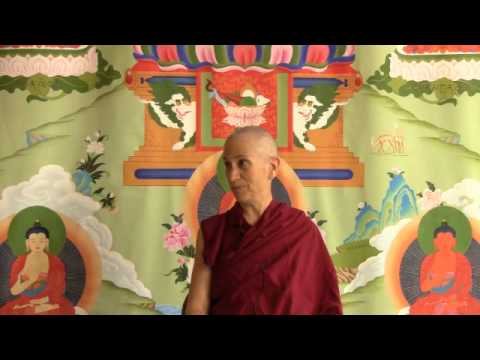Concentration and the five absorption factors
Stages of the Path #128: The Fourth Noble Truth
Part of a series of Bodhisattva's Breakfast Corner talks on the Stages of the Path (or Lamrim) as described in the Guru Puja text by Panchen Lama I Lobsang Chokyi Gyaltsen.
- Different meanings of the three realms: the desire, form, and formless realms
- How beings are born into the form and formless realms based on levels of concentration
- How beings in the desire realm can access levels of concentration of the form and formless realms
We’ve been talking about cultivating concentration and we went through the five hindrances. I want to now talk about what are called the five absorption factors.
As you are practicing concentration and reducing the five hindrances you’re at the same time strengthening the five absorption factors. When you’ve suppressed the five hindrances so that they aren’t disturbing your concentration then you’ve attained what’s called serenity (or shamatha). When that also brings a sense of physical and mental pliancy and physical and mental bliss—and that is serenity (or shamatha)—and that’s called the access concentration. You don’t have the first jhana (dhyana) yet, but you have the access to it, and you’ve developed these five factors very well. But when these five factors are fully developed and the hindrances are suppressed, then you attain the first jhana.
In talking about these realms, we have to talk about there’s the desire realm, the form realm, and the formless realm. These three are realms into which sentient beings are born, but they’re also domains of consciousness.
We are currently in the desire realm. The desire realm. And it’s so called because the beings born in it are full of desire for sense objects. Anyone want to volunteer? We’re just hooked on sense objects. Within the desire realm you have the hellish beings, the hungry ghosts, the animals, human beings, the demi-gods, and then the six levels of desire realm gods. These are all within the desire realm.
Then you have the form realm. The form realm, they have bodies of light, and there are four form realms: the first, second, third, and fourth. They each have different subdivisions, so you get seventeen, I believe it is, all together. This is where beings like Brahma and so forth are born, different kinds of worldly gods. Many of them are born there, some are born in the six desire-realm gods.
Then above the four form realm absorptions you have the four formless realm absorptions. These beings are formless in that they don’t have a physical aggregate (or according to tantra they have a very subtle one, but according to sutra they don’t have a physical aggregate), and they just have the four mental aggregates.
All three of these realms—desire, form, and formless—are within cyclic existence, and you’re born in the form and formless realms based on the degree of concentration that you have. Somebody can have a human body physically, and if they develop very powerful concentration—not only serenity (or shamatha), but if they actually enter the first jhana—then they’re born in the human realm but their mind—when they are in that deep concentration—is a mind of the first jhana. In other words, they have that level of concentration. Then they can deepen their concentration and attain a mind of the second jhana, of the third jhana, the fourth, and up through the four formless realms. The four formless realms you have infinite space, infinite consciousness, nothingness, and then the peak of samsara, which is called “neither discrimination or non-discrimination.” Those are the names of the four formless realms. So, somebody can have a human body, but if they’re very well trained in concentration their mind, when they’re in those states of concentration, can be at a different level, a different realm, than what their body’s in.
But let’s say somebody practices these deep states of concentration with the intention to be born into them—not to attain liberation—then if in this life they attain the level of concentration of the first jhana, then after death, by the force of that karma, which is called unwavering karma because it doesn’t waver from the kind of rebirth it brings, it only brings rebirth in the first jhana, not in the second, not in the desire realm, anything like that. If somebody, let’s say, accesses a higher or deeper level of concentration then that immovable karma, or unwavering karma, will cause them to be born in the future life in that actual realm, where they’re a being of that realm. Whereas now they’re a being in the desire realm.
Now, of course, they always say it’s better to have a human body and then be able to access the concentrations, the absorptions on the basis of a human body, because if you’re born into these higher realms it’s very easy…. The bliss of the concentration is so seductive that it’s easy to get stuck in it. However, there are people progressing on the level of stream enterer and non-returner, and once-returner, and arhat, as well as certain bodhisattvas, that do get born in those realms. Probably more-so the form realms, because the formless realms the mind is so subtle, the concentration is so deep, that it’s really very difficult to do any analysis of the type that you need to do in order to realize emptiness.
That’s just a lay of the land, and then I’ll talk about these five jhanic factors in the next upcoming days.
[In response to audience] If you’re on the bodhisattva path how do you make sure you don’t wind up getting born there and then distracted by the concentration? You pray for a precious human life. You pray to never be separated from Mahayana teachers. It depends a lot on how you dedicate.
[In response to audience] When a human being has a concentration of the third jhana, do they temporarily gain a light body? No. they still have this body. That’s the difference between being born as a being in that realm and having a mind state in the domain of that realm.
Audience: Can someone who’s in, say, the third jhana do second jhana meditations?
Venerable Thubten Chodron: Yes, as far as I know they can. And actually as people, especially the bodhisattvas, when you read about their concentration abilities, and even the people on the hearer and solitary realizer path, they learn to go through all these jhanas and then go back down them, and the bodhisattvas can go in and out of different stages, they say, at a finger snap. And we’re just trying to keep the mind on the object for two seconds. But it’s possible to develop the mind to those stages, where you can go in and out of these stages very, very quickly. I mean, it takes a lot of practice.
[In response to audience] I think the devas in Ajahn Mun’s biography, I think most of them were the desire realm devas, as far as I understand. Maybe there might have been some from the higher realms.
Venerable Thubten Chodron
Venerable Chodron emphasizes the practical application of Buddha’s teachings in our daily lives and is especially skilled at explaining them in ways easily understood and practiced by Westerners. She is well known for her warm, humorous, and lucid teachings. She was ordained as a Buddhist nun in 1977 by Kyabje Ling Rinpoche in Dharamsala, India, and in 1986 she received bhikshuni (full) ordination in Taiwan. Read her full bio.


